Your cart is currently empty!
Golden Reflections: The Majesty of the Manhattan Skyline at Sunset
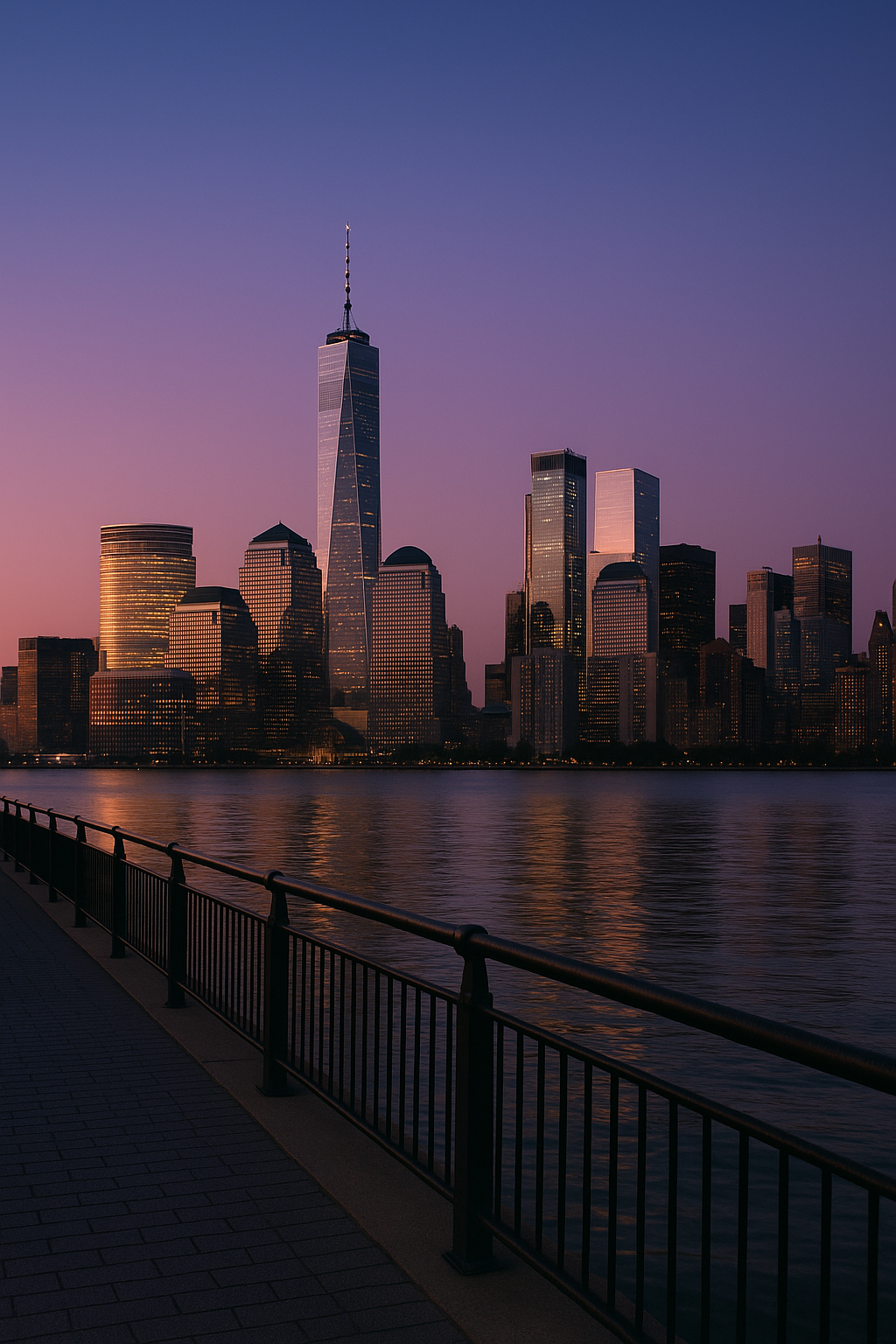
There are few sights in the world that rival the Manhattan skyline glowing at sunset. As the day fades and the light softens, the glass towers of Lower Manhattan turn molten gold, their reflections shimmering across the calm waters of the Hudson River. It’s a view that captures the heart of New York City — bold, brilliant, endlessly alive — and one that has inspired countless photographers, travelers, and dreamers for more than a century.
This is more than just a skyline; it’s a story told in steel and light. From the soaring pinnacle of One World Trade Center to the gleaming banks of the Hudson, the Manhattan skyline represents resilience, ambition, and the unshakable belief that anything is possible. Watching it at sunset feels almost cinematic — the city transforms into a living painting, one that changes minute by minute as the sun dips behind the horizon and the first stars blink awake over the river.
In this article, we’ll explore the magic of the Manhattan skyline at golden hour — how it came to be, what it symbolizes, and why standing before it at sunset feels like standing before a dream made real.
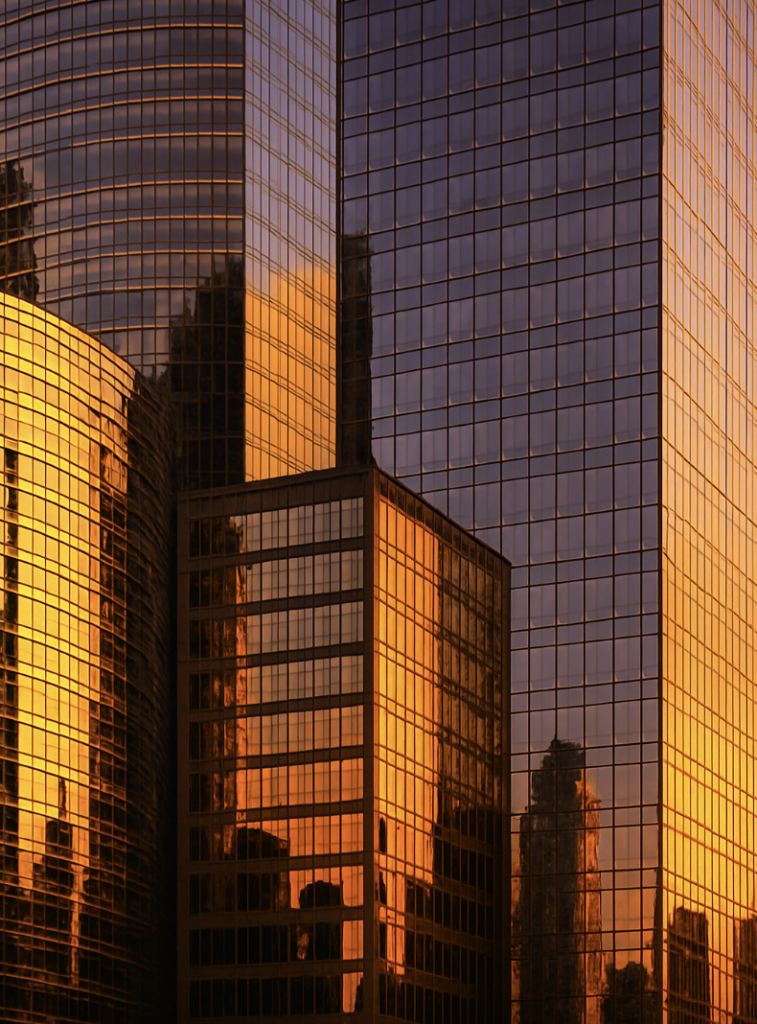
The Beating Heart of New York City
Manhattan is not just a place on a map; it’s an idea. It’s where the modern city was born — a space defined by movement, ambition, and reinvention. The skyline of Lower Manhattan, in particular, tells the story of New York’s evolution. From the days when sailing ships filled the harbor and warehouses lined the piers, to today’s sleek skyscrapers of glass and steel, every building is a chapter in the city’s unfolding narrative.
The image of the Manhattan skyline, bathed in golden sunlight, is one of the most recognized in the world. It embodies everything people imagine when they think of New York: power, opportunity, innovation, and unyielding spirit. Even from across the river, the sheer density of the buildings creates a silhouette unlike any other — a vertical city rising straight from the water, glistening like a crown in the evening light.
At the center of this view stands the One World Trade Center, the tallest building in the Western Hemisphere and a beacon of hope and resilience. Its shimmering façade mirrors the changing sky, transforming from silver to gold to deep indigo as night approaches. The building’s tapering geometry and striking spire seem to pull the eye upward, reminding everyone who sees it that New York’s spirit reaches ever higher.
The Architecture of Ambition
The Manhattan skyline is not an accident of geography — it’s a masterpiece of human ambition. Each building reflects a different era of design, technology, and vision, yet together they form a seamless and harmonious whole. To watch them glowing in the sunset is to see the story of a century told through architecture.
The One World Trade Center, completed in 2013, rises from the site of the original Twin Towers as both a memorial and a triumph of engineering. At 1,776 feet tall, its height is symbolic — a tribute to the year of American independence — and its design evokes both strength and transparency. The glass panels reflect the sky and water, blending the building into its surroundings and turning it into a living sculpture of light.
Surrounding it are other architectural gems of Lower Manhattan: the curved silver façade of the Goldman Sachs Tower, the reflective surfaces of the World Financial Center, and the sleek symmetry of the Battery Park City buildings. Each catches the evening light differently, some glowing like fire, others gleaming in soft champagne tones. The curved glass walls and sharp edges create a dance of reflections, as the sun slips lower and the colors deepen into amber and rose.
The result is pure poetry — a city that seems to be built out of light itself.
The Magic of Golden Hour
The period just before sunset — known as golden hour — is one of the most enchanting times to see the Manhattan skyline. The sun hangs low in the sky, casting a warm, golden hue that softens shadows and highlights every curve and contour. It’s when the city seems to exhale, caught between the rush of the day and the glow of the evening.
As the sun sets over the Hudson River, the tall towers of Lower Manhattan catch the last light of day, reflecting it like mirrors into the water below. The buildings become almost translucent, their glass surfaces turning molten orange, while the river becomes a rippling canvas of color — gold, copper, lavender, and deepening blue.
This interplay of light and reflection is what makes the view so unforgettable. Every few moments, it changes. The colors shift, the brightness fades, and new details emerge. The skyline becomes a living thing, breathing light and shadow, capturing the fleeting beauty of time itself.
Photographers call this the “magic hour” — the perfect moment when natural light transforms the ordinary into the extraordinary. But you don’t need a camera to feel it. Whether standing on the Brooklyn waterfront, riding the Staten Island Ferry, or walking along Battery Park, the experience of watching Manhattan turn to gold is enough to make anyone stop, breathe, and feel part of something bigger.
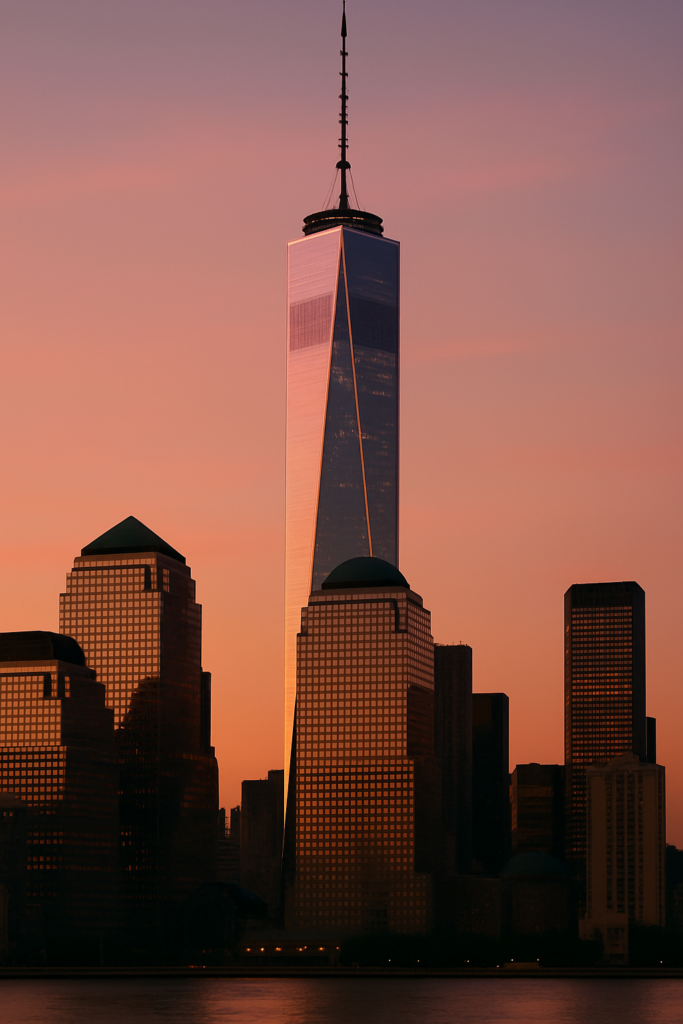
Reflections on the River
The Hudson River is as much a part of New York’s identity as its buildings. Flowing between the towers and the setting sun, it acts as both a mirror and a mood — calm one moment, shimmering the next. At sunset, the river becomes a sheet of glass, reflecting the entire skyline in rippling perfection.
The reflection doubles the beauty — the golden towers above, their liquid counterparts below. The One World Trade Center, in particular, casts a brilliant path of light across the surface, creating a visual link between earth and sky. Ferries drift by, their wakes spreading ripples that distort and dance with the reflections, as if the river itself were alive and responding to the city’s heartbeat.
It’s a view that never grows old. Locals pause to take it in after work; visitors travel thousands of miles to see it in person. The river at sunset reminds everyone that even in a city that never sleeps, there are moments of stillness — moments when nature and architecture find harmony.
The Symbolism of the Skyline
Beyond its beauty, the Manhattan skyline carries deep meaning. It stands as a symbol of human achievement — of what can be built when imagination and determination meet. But it also tells a story of resilience. The skyline has changed dramatically over the years, weathering disasters, economic upheavals, and transformations both planned and unexpected. Yet it always rises again, stronger, taller, brighter.
The skyline you see today is a testament to renewal. The One World Trade Center, in particular, embodies this spirit. Rising from the site of loss, it was designed not just as an office building, but as a symbol of unity, strength, and remembrance. Its spire reaches toward the sky like a statement of hope — a reminder that even out of darkness, light returns.
At sunset, this symbolism becomes almost tangible. The golden light pouring over the buildings feels like a benediction, a daily ritual of rebirth. The city glows as if to say: we endure, we rebuild, we rise.
For many, that’s what makes the Manhattan skyline so moving. It’s not just architecture — it’s emotion, history, and human aspiration made visible.
The Experience of Being There
Standing before the Manhattan skyline at sunset is an experience that words can only partially capture. The air feels charged, the light warm against your skin. The sound of the city — distant horns, murmuring voices, the rhythm of the water — forms a kind of music. The colors change every minute, and with each shift, the scene transforms: gold to rose, rose to violet, violet to the deep indigo of night.
As darkness settles, the city lights begin to sparkle. Windows flicker to life, reflections shimmer more vividly, and the skyline takes on a new identity — no longer glowing with sunlight but with its own electric heartbeat. The glass towers become lanterns in the night, guiding ships and souls alike.
From the Brooklyn waterfront or the ferries gliding across the river, the skyline feels like a dream just out of reach — vast, luminous, and eternal. It’s easy to see why so many fall in love with New York in these moments. The skyline is not just a view; it’s a feeling — of wonder, possibility, and connection to something larger than oneself.
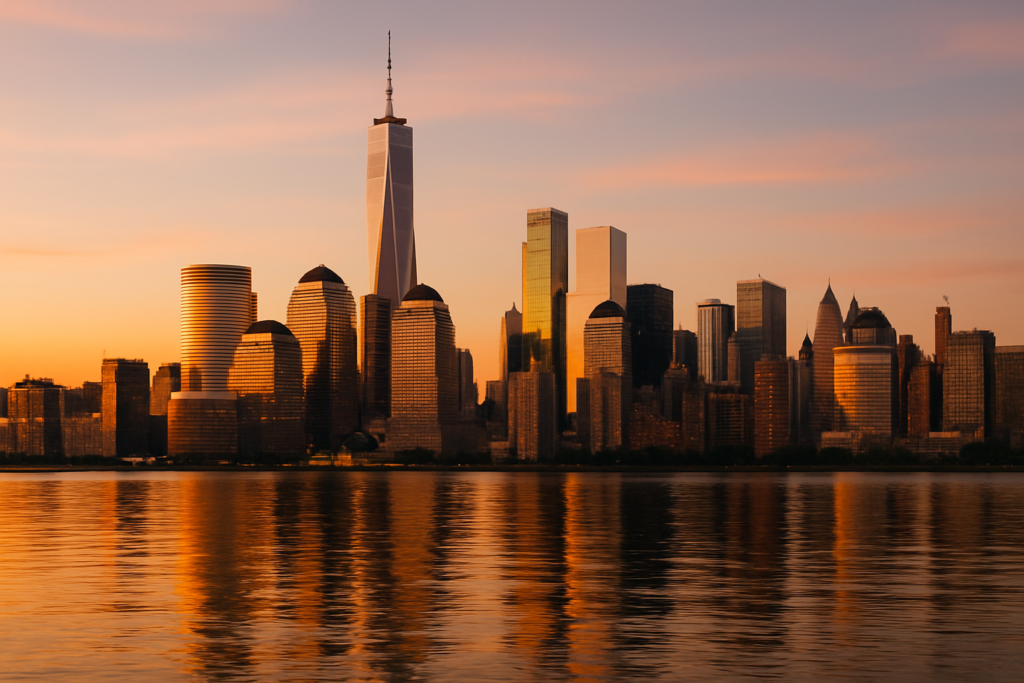
The Evolution of the Skyline
What makes the Manhattan skyline even more remarkable is its evolution. It’s not frozen in time — it grows, changes, and adapts, reflecting the city’s ever-shifting identity. The skyline of a hundred years ago was dominated by stone and brick; today it’s a symphony of glass and steel. Yet somehow, the essence remains the same: vertical ambition.
In the early 20th century, Lower Manhattan was already the center of commerce and finance. Buildings like the Woolworth Building and the Equitable Life Building defined the early skyline. By the 1930s, Midtown began to rise, with icons like the Empire State Building and Chrysler Building shaping the image of New York known around the world.
After the tragic events of September 11, 2001, the skyline changed again. The absence of the Twin Towers left an ache in the city’s silhouette — but the rebuilding of the site, crowned by One World Trade Center, was both an act of remembrance and of hope. Today, the skyline stands not as a reminder of loss, but as a promise of resilience.
That constant renewal is part of what makes Manhattan timeless. Each decade brings new structures, new heights, new ideas. Yet the skyline’s essence — that feeling of limitless possibility — never fades.
Why the Skyline Matters
Why does this view matter so much? Because it represents something far beyond architecture or geography. The Manhattan skyline is a universal symbol of aspiration. It tells every person who looks at it that dreams are worth chasing, that progress is possible, and that beauty can arise even from hardship.
For New Yorkers, it’s a part of daily life — a familiar friend they glimpse on their commute or from their window. For visitors, it’s a moment of awe, a reminder that they’ve arrived in one of the greatest cities on Earth. For artists, it’s a muse. For photographers, it’s a lifelong obsession.
And for everyone who’s ever stood on the banks of the Hudson at sunset and watched the towers turn to gold, it’s something even more personal — a feeling that transcends words. A sense that for all its chaos and complexity, the world still contains wonder.
A Living Masterpiece
The Manhattan skyline at sunset is a living masterpiece — one that no painter could ever quite capture, because it never stops changing. The light, the weather, the season, even the mood of the day all play a part. On some evenings, the sky burns orange and crimson; on others, it glows softly in peach and lavender. The reflections on the water shift and shimmer, sometimes sharp and clear, other times hazy and dreamlike.
The buildings themselves change, too. As the sun sets, their reflections move, their glass panels catching and bending the light differently every minute. The skyline becomes a performance — not static, but dynamic, unfolding in real time. And just when it reaches its most breathtaking moment, the sun slips below the horizon and night begins.
The city doesn’t fade; it transforms. The warm sunlight gives way to cool electric light. The skyline that glowed gold now sparkles silver and blue. The energy changes from serene to vibrant, from calm to alive. And as the stars appear faintly above, the lights of the city form their own constellation below — a galaxy of human creation.
The Timeless Power of Light and Reflection
Ultimately, what makes the Manhattan skyline so mesmerizing — especially at sunset — is the interplay of light and reflection. Light defines New York: the way it bounces off glass, glows on water, filters through clouds, and illuminates the night. The city seems built not just of materials, but of light itself.
Every reflection in the river feels like an echo of the sky, a conversation between nature and architecture. The buildings, designed for function, become canvases for beauty. The water, shaped by tides, becomes a mirror for dreams. Together they create a harmony that feels almost spiritual — a balance between chaos and calm, between man-made order and natural wonder.
It’s easy to see why so many artists and poets have been inspired by this view. It’s not just the sight of the skyline that moves people — it’s what it represents: the blend of human creation with natural grace, the dialogue between permanence and change.
Conclusion: The City of Light, Reflected
As the last light fades from the sky and the Manhattan skyline begins to shimmer with its own inner glow, it’s impossible not to feel a sense of awe. The sight of One World Trade Center gleaming above the river, the gold reflections on glass, the calm ripples of the Hudson catching the colors of the sky — all of it reminds you why New York is often called the city of dreams.
The Manhattan skyline at sunset is not just an image; it’s an experience. It captures the very essence of New York — its energy, resilience, elegance, and light. Whether seen from a ferry, a rooftop, or the opposite shore, it leaves an imprint on everyone who witnesses it.
And perhaps that’s the true magic of this golden hour — that for a few brief moments each day, amidst all the movement and noise, the city stands still. It glows. It breathes. It reflects not just sunlight, but the endless human spirit that built it. In the end, the skyline is more than a view — it’s a reminder that beauty can rise from ambition, and light can always find its way through the tallest towers of steel and glass.
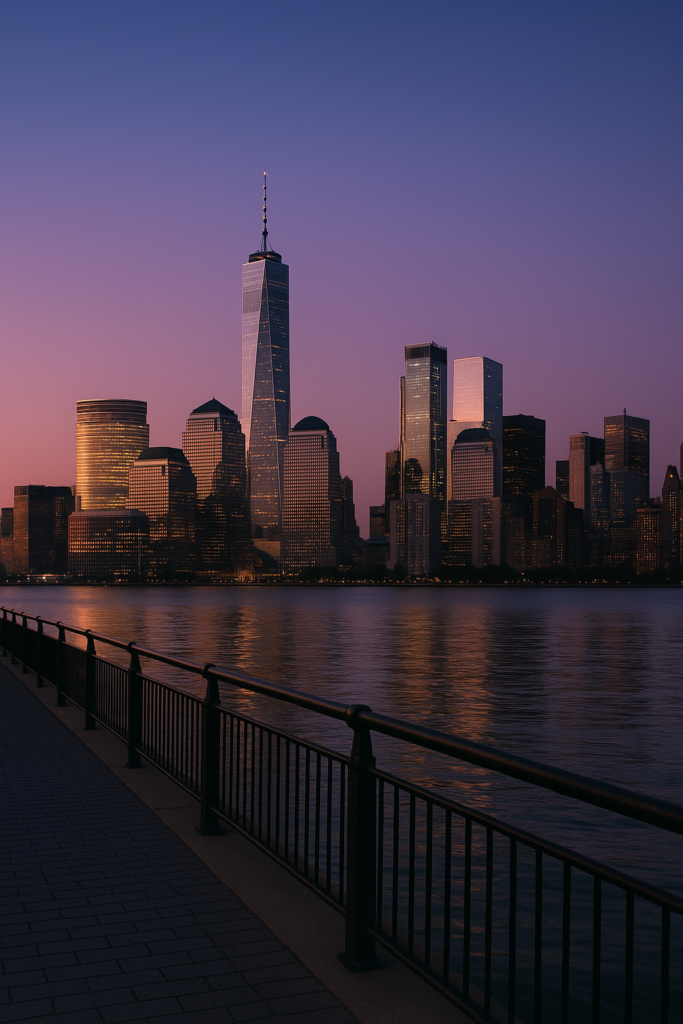

Leave a Reply